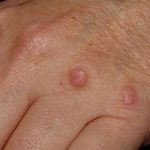 A reactive nodule consisting of modified macrophages resembling epithelial cells surrounded by a rim of mononuclear cells, usually lymphocytes, and often containing giant cells.
A reactive nodule consisting of modified macrophages resembling epithelial cells surrounded by a rim of mononuclear cells, usually lymphocytes, and often containing giant cells.
A relatively small nodular inflammatory lesion containing grouped mononuclear phagocytes, caused by infectious and noninfectious agents.
One of a variety of growths of inflamed, granular-appearing tissue.
Infiltration of tissue phagocytes, producing a granular matrix in the area of the invading parasite.
A mass of granulation tissue which forms at the site of bacterial infections.
Mass of nodular granulation tissue resulting from injury, infection, or inflammation. Treatment depends on the cause and probable course of the granuloma.
A diseased growth characterized by a mass of granulation tissue (tissue that develops in a wound during the healing process). Types of granuloma include granuloma annulare, granuloma inguinale, and pyogenic granuloma. In granuloma annulare, round (annular) skin lesions resembling ringworm most commonly appear on the hands and feet. Treatment is typically with prescription corticosteroid creams or ointments. In severe cases, the doctor will prescribe oral medications. Granuloma inguinale, one of the sexually transmitted diseases (STDs), causes the erosion and destruction of genital tissue. This disease, commonly found in tropical areas, is rare in the United States. In pyogenic granuloma, small, elevated, vascular lesions appear on the skin following an injury. Although harmless, they bleed easily. Many disappear without treatment, while others must be removed using a method such as cauterization, freezing, or lasers.
A mass of granulation tissue produced in response to chronic infection, inflammation, a foreign body, or to unknown causes. Infections giving rise to granulomas include tuberculosis, syphilis, granuloma inguinale, leprosy, and some fungal diseases, such as coccidioidomycosis. Granulomas may occur as reactions to such foreign bodies as starch and talc following surgical procedures or to some metals, such as beryllium and zirconium. Sarcoidosis and Crohn’s disease are granulomatous diseases of which the causes are not known.
A non-malignant or new growth made up of granulation tissue. This is caused by various forms of chronic inflammation, such as syphilis and tuberculosis.
An inflammatory response that results when macrophages are unable to destroy foreign substances that have entered or invaded body tissues. Large numbers of macrophages are drawn to the affected area over 7 to 10 days, surround the target, and enclose it. They in turn are surrounded by polymorphonuclear leukocytes, other immune cells, and fibroblasts. Granulomas are common in many conditions, including leprosy, tuberculosis, cat scratch disease, some fungal infections, and foreign body reactions (e.g., reactions to sutures).
An inflammatory enlargement or formation comprised of granulation tissue.
A granuloma is an abnormal growth composed of cells typically associated with chronic inflammation. It often develops as a reaction to specific infections like tuberculosis or in response to foreign bodies, such as sutures (stitches). Additionally, granulomas may form for unknown reasons in conditions like sarcoidosis.
A pyogenic granuloma refers to an excessive growth of granulation tissue that develops at the site of an injury on the skin or mucous membrane.
A growth made up of granulation tissue. One type of such a growth is known as “proud flesh,” which can appear in a surface ulcer.
